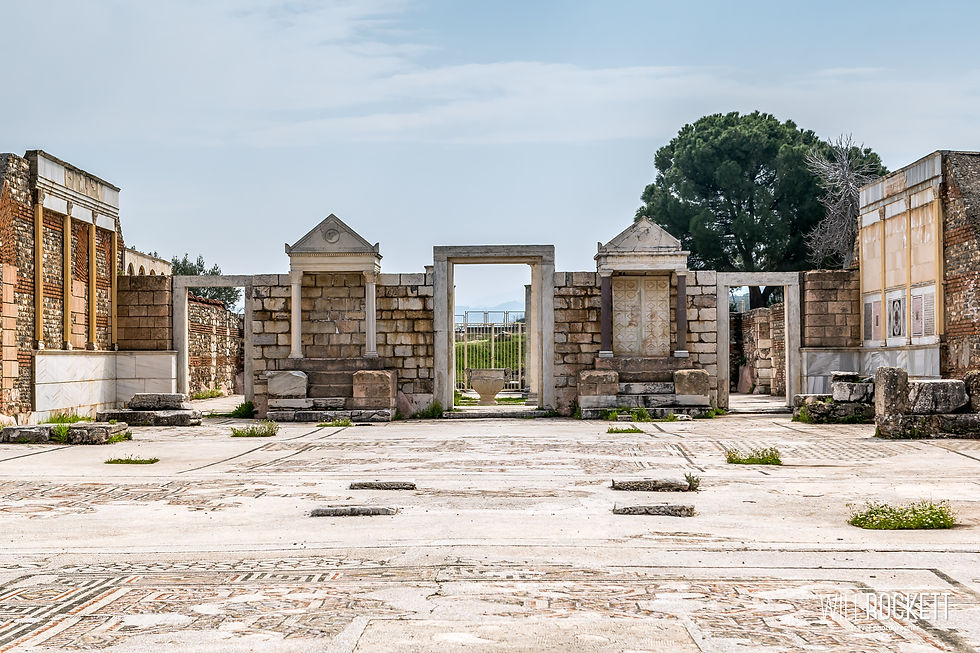Jews in Ancient Asia Minor
- Jason Borges

- Jul 5, 2022
- 3 min read
Updated: Sep 14, 2022
Jewish people lived throughout Asia Minor during the Hellenistic and Roman eras. This is significant in its own right, and also important for understanding early Christian history, as Christianity started as a “Jewish sect” and often spread through Jewish communities. This post will summarize the primary sources of evidence for Jewish communities in ancient Asia Minor. Two qualifications are in order. One, the evidence is quite abundant, so we mention only the prominent cases. Two, our mentions points only toward the locations of Jewish communities, not the nature of those communities or how they lived in the diaspora.

TEXTS
The earliest evidence of a Jewish presence in the region comes from Jewish texts. The Jewish historian Josephus reports that the Hellenistic/Seleucid king Antiochus III (d. 187 BCE) relocated 2,000 Jewish families from Babylon to Lydia and Phrygia (Jewish Ant. 12.3.4). He considered them loyal and pious subjects, and so he granted them land and allowed them to live according to their own laws. Jewish migrants and traders probably traveled west from Jerusalem during the exilic and Hellenistic period, but this is the first historical reference to Jews in Asia Minor. In 1 Maccabees 15, Antiochus VII issues a decree to Jews in Caria, Pamphylia, Lycia, Halicarnassus (Bodrum), Phaselis (near Antalya), Side (near Antalya), and Cnidus (ca. 140 BCE).
Early Christian texts also provide evidence of Jews in Asia Minor. Acts 2 mentions that Jews from Cappadocia, Pontus, Asia, Phrygia, and Pamphylia (among other regions) were visiting Jerusalem during Pentecost. In the second half of Acts, Paul encounters Jewish communities in Antioch, Iconium, Lystra, and Ephesus. In Revelation 2–3, John mentions synagogues in Smyrna and Philadelphia. These Jewish and Christian references illustrate the breadth of Jewish communities in ancient Asia.
SYNAGOGUES
Synagogues are the most obvious physical evidence of a Jewish presence. In general, the synagogues in Asia date to the late antique period (4C–7C CE) and are concentrated in the regions of Caria and Lycia. We only list them here. You can read the linked publications for more information.
Sardis. This is the largest synagogue in the Jewish diaspora, standing in the city center near the gymnasium. Many articles have been published, and the final report should appear soon. Read a summary here.
Priene (article). On the western edge of town, a house was converted into a synagogue. The structure was discovered in the late 1800s and fully excavated in 2010.
Andriake/Myra (article). A two-story synagogue near the granary in a prominent location at Myra’s ancient port was discovered in 2010.
Side. A small synagogue with a dedicatory inscription was recently unearthed in Side (east Pamphylia). The finding has been reported through news sites, but not yet published.
In addition to those four incontrovertible synagogues, another three structures are possible synagogues.
Limyra (article). At this site near Finike, Antalya, two stones with menorahs were discovered inside the East Gate. The structure hasn’t been excavated yet, so its identification as a synagogue remains a hypothesis.
Miletus. Near the Harbor monument, a structure that resembles a synagogue was identified in the early 1900s, but the site has not been excavated. An inscription in the theater seats reads, “Place of the Jews, (and?) those who are God-fearers.”
Mopsuestia (Misis, Adana). The magnificent mosaic of Noah’s ark (now housed at the Adana Archaeology Museum) was discovered on the western edge of Mopsuestia. The mosaic could have been part of a Jewish synagogue or Christian church.
MENORAHS
The menorah—a seven-branched lampstand—was a symbol of the Jewish people. The shape was commonly carved into stones and many have been found in cities throughout Asia Minor. They provide the most widespread evidence of Jewish communities. For example, two menorahs repurposed as spolia in a house and a city wall in Side were known long before the recent synagogue discovery. I even encountered a menorah at the Kaman Kalehöyük museum near Kirşehir. Inscribed menorahs are often flanked by a palm branch and lulav (i.e., round date fruit).
Notable examples include the menorah with a superimposed cross at Laodicea (article), the recently discovered menorah inscription from Antalya (article), the menorah on the step of the Library of Celcus in Ephesus, and menorahs found on several monumental burial rooms in the necropolis at Hierapolis.
INSCRIPTIONS AND TOMBSTONES
In many instances, Jewish people inscribed a message into stone. This could be for a public inscription or on a tomb. In one famous inscription, a large, square monolith with the names of 71 Jews and 54 God-fearers was found in Aphrodisias. The inscription seems to record the donors of a public soup kitchen established around 200 CE. Many other Jewish inscriptions have been found in Asia Minor, but they may be the result of just an individual, not a community.
CONCLUSION
Textual references, synagogue remains, inscribed menorahs, and written inscriptions are important sources for identifying Jewish communities in ancient Asia Minor. For more, see the recent volume Jewish Identity Engraved in Stones/ Taşlara Kazınan Yahudi Kimliği (2001).




Comments